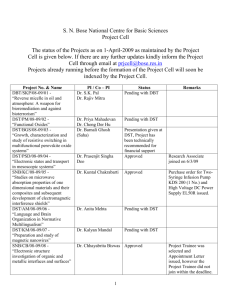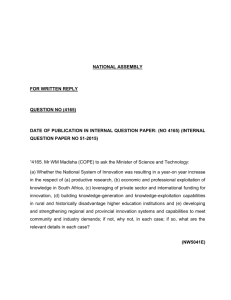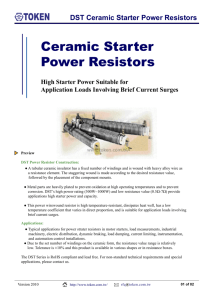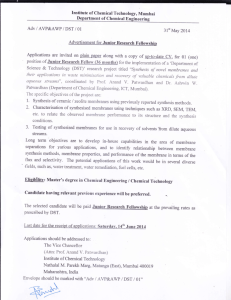msp430_notes_unit_8
advertisement
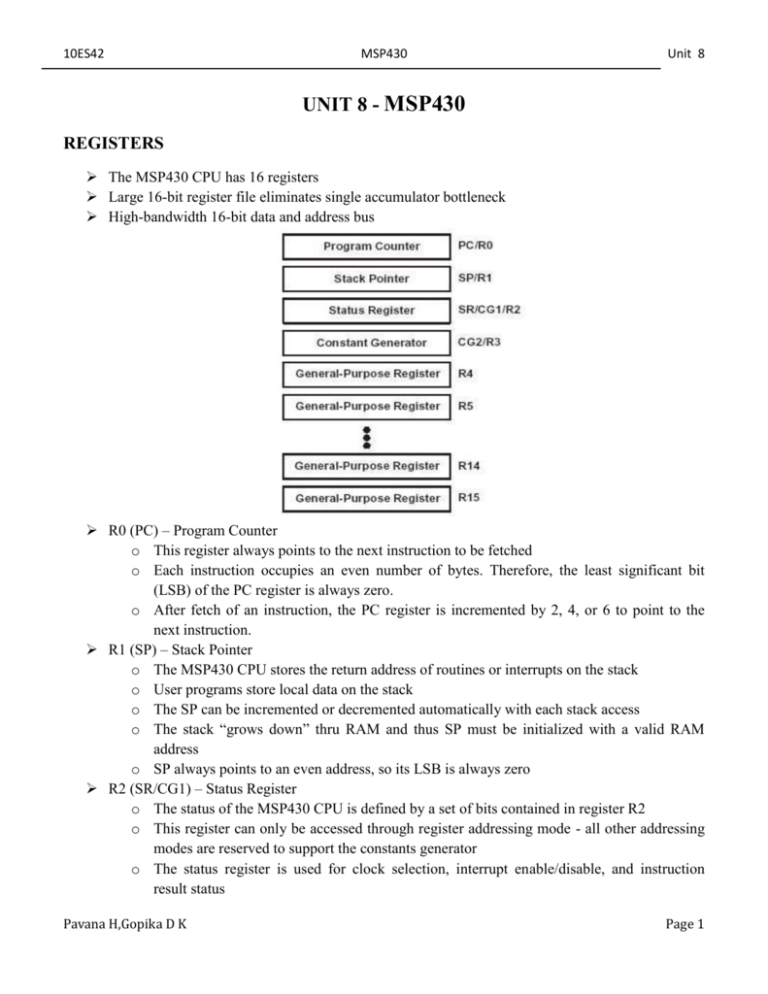
10ES42 MSP430 Unit 8 UNIT 8 - MSP430 REGISTERS The MSP430 CPU has 16 registers Large 16-bit register file eliminates single accumulator bottleneck High-bandwidth 16-bit data and address bus R0 (PC) – Program Counter o This register always points to the next instruction to be fetched o Each instruction occupies an even number of bytes. Therefore, the least significant bit (LSB) of the PC register is always zero. o After fetch of an instruction, the PC register is incremented by 2, 4, or 6 to point to the next instruction. R1 (SP) – Stack Pointer o The MSP430 CPU stores the return address of routines or interrupts on the stack o User programs store local data on the stack o The SP can be incremented or decremented automatically with each stack access o The stack “grows down” thru RAM and thus SP must be initialized with a valid RAM address o SP always points to an even address, so its LSB is always zero R2 (SR/CG1) – Status Register o The status of the MSP430 CPU is defined by a set of bits contained in register R2 o This register can only be accessed through register addressing mode - all other addressing modes are reserved to support the constants generator o The status register is used for clock selection, interrupt enable/disable, and instruction result status Pavana H,Gopika D K Page 1 10ES42 MSP430 Unit 8 V Overflow bit – set when arithmetic operation overflows the signed-variable range. SCG1 System clock generator 1 – turns off the SMCLK. SCG0 System clock generator 0 – turns off the DCO dc generator. OSCOFF Oscillator off – turns off the LFXT1 crystal oscillator. CPUOFF CPU off – turns off the CPU. GIE General interrupt enable – enables maskable interrupts. N Negative bit – set when the result of a byte or word operation is negative. Z Zero bit – set when the result of a byte or word operation is 0. C Carry bit – set when the result of a byte or word operation produces a carry. R2 (SR/CG1), R3 (CG2) – Constant Generators o Six different constants commonly used in programming can be generated using the registers R2 and R3, without adding a 16-bit extension word of code to the instruction R4-R15 – General Purpose registers o The general purpose registers R4 to R15 can be used as data registers, data pointers and indices. o They can be accessed either as a byte or as a word o Instruction formats support byte or word accesses o The status bits of the CPU in the SR are updated after the execution of a register instruction. Pavana H,Gopika D K Page 2 10ES42 MSP430 Unit 8 ADDRESSING MODES 1. Source Addressing Modes: The MSP430 has four basic modes for the source address: Rs - Register x(Rs) - Indexed Register @Rs - Register Indirect @Rs+ - Indirect Auto-increment In combination with registers R0-R3, three additional source addressing modes are available: label - PC Relative, x(PC) &label – Absolute, x(SR) #n – Immediate, @PC+ 2. Destination Addressing Modes: There are two basic modes for the destination address: Rd - Register x(Rd) - Indexed Register In combination with registers R0/R2, two additional destination addressing modes are available: label - PC Relative, x(PC) &label – Absolute, x(SR) 1. Register Mode (Rn) o The most straightforward addressing mode and is available for both source and destination o Example: mov.w r5, r6 ; move word from r5 to r6 o The registers are specified in the instruction; no further data is needed o Also the fastest mode and does not require an addition cycle o Byte instructions use only the lower byte, but clear the upper byte when writing 2. Indexed Mode x(Rn) o The address is formed by adding a constant (index) to the contents of a CPU register o Example: mov.b 3(r5),r6 ; move byte from ; M(310+r5) to r6 o Indexed addressing can be used for source and/or destination o The index is located in the memory work following the instruction and requires an additional memory cycle (If the index cannot be generated by the constant generator) o There is no restriction on the address for a byte, but words must lie on even addresses Pavana H,Gopika D K Page 3 10ES42 MSP430 Unit 8 3. Symbolic Mode (PC Relative) o The address if formed by adding a constant (index) to the program counter (PC) o Example: mov.w Cnt,r6 ; move word ; M(Cnt+PC) to r6 o The PC relative index is calculated by the assembler o Produces position-independent code, but rarely used in the MSP430 because absolute addressing can reach all memory addresses o Note: this is NOT an appropriate mode of addressing when referencing fixed locations in memory such as the special function registers (SFR’s) 4. Absolute Mode (&label) o The address is formed directly from a constant (index) and specified by preceding a label with an ampersand (&) o Example: mov.w &Cnt,r6 ; move word ; Cnt to r6 o Same as indexed mode with the base register value of 0 (by using the status register SR as the base register) o The absolute address is stored in the memory word following the instruction and requires an additional cycle o Note: this is the preferred mode of addressing when referencing fixed locations in memory such as the special function registers (SFR’s) 5. Indirect Register Mode (@Rn) o The address of the operand is formed from the contents of the specified register o Example: mov.w @r5,r6 ; move word ; M(r5) to r6 o Only available for source operands o Same as indexed mode with index equal to 0, but does not require an additional instruction word o The value of the indirect register is unchanged 6. Indirect Autoincrement Mode (@Rn+) o The address of the operand is formed from the contents of the specified register and afterwards, the register is automatically increment by 1 if a byte is fetched or by 2 if a word is fetched o Example: mov.w @r5+,r6 ; move word Pavana H,Gopika D K Page 4 10ES42 MSP430 Unit 8 ; M(r5) to r6 ; increment r5 by 2 o Only available for source operands. o Usually called post-increment addressing. o Note: All operations on the first address are fully completed before the second address is evaluated 7. Immediate Mode (#n) o The operand is an immediate value o Example mov.w #100,r6 ; 100 -> r6 o The immediate value is located in the memory word following the instruction o Only available for source operands o The immediate mode of addressing is a special case of auto-increment addressing that uses the program counter (PC) as the source register. o The PC is automatically incremented after the instruction is fetched; hence points to the following word ADDRESSING SUMMARY Pavana H,Gopika D K Page 5 10ES42 MSP430 Unit 8 INSTRUCTIONS Double operand instructions: Mnemonic Operation Description ADD(.B or .W) src,dst src+dstdst Add source to destination ADDC(.B or .W) src,dst src+dst+Cdst Add source and carry to destination DADD(.B or .W) src,dst src+dst+Cdst (dec) Decimal add source and carry to destination SUB(.B or .W) src,dst dst+.not.src+1dst Subtract source from destination SUBC(.B or .W) src,dst dst+.not.src+Cdst Subtract source and not carry from destination Arithmetic instructions Logical and register control instructions AND(.B or .W) src,dst src.and.dstdst AND source with destination BIC(.B or .W) src,dst .not.src.and.dstdst Clear bits in destination BIS(.B or .W) src,dst src.or.dstdst Set bits in destination BIT(.B or .W) src,dst src.and.dst Test bits in destination XOR(.B or .W) src,dst src.xor.dstdst XOR source with destination CMP(.B or .W) src,dst dst-src Compare source to destination MOV(.B or .W) src,dst srcdst Move source to destination Data instructions Pavana H,Gopika D K Page 6 10ES42 MSP430 Unit 8 Single operand instructions: Mnemonic Operation Description Logical and register control instructions RRA(.B or .W) dst MSBMSB… LSBC Roll destination right RRC(.B or .W) dst CMSB…LSBC Roll destination right through carry SWPB( or .W) dst Swap bytes Swap bytes in destination SXT dst bit 7bit 8…bit 15 Sign extend destination PUSH(.B or .W) src SP-2SP, src@SP Push source on stack Program flow control instructions CALL(.B or .W) dst SP-2SP, PC+2@SP dstPC Subroutine call to destination RETI @SP+SR, @SP+SP Return from interrupt Pavana H,Gopika D K Page 7 10ES42 MSP430 Unit 8 Emulated Instructions o In addition to the 27 instructions of the CPU there are 24 emulated instructions o The CPU coding is unique o The emulated instructions make reading and writing code more easy, but do not have their own op-codes o Emulated instructions are replaced automatically by instructions from the CPU o There are no penalties for using emulated instructions. Mnemonic Operation Emulation Description Arithmetic instructions ADC(.B or .W) dst dst+Cdst ADDC(.B or .W) #0,dst Add carry to destination DADC(.B or .W) dst dst+Cdst (decimally) DADD(.B or .W) #0,dst Decimal add carry to destination DEC(.B or .W) dst dst-1dst SUB(.B or .W) #1,dst Decrement destination DECD(.B or .W) dst dst-2dst SUB(.B or .W) #2,dst Decrement destination twice INC(.B or .W) dst dst+1dst ADD(.B or .W) #1,dst Increment destination INCD(.B or .W) dst dst+2dst ADD(.B or .W) #2,dst Increment destination twice SBC(.B or .W) dst dst+0FFFFh+Cdst SUBC(.B or .W) #0,dst Subtract source and /.NOT. carry from dest. borrow dst+0FFhdst Logical and register control instructions INV(.B or .W) dst .NOT.dstdst XOR(.B or #0(FF)FFh,dst RLA(.B or .W) dst CMSBMSB-1 LSB+1LSB0 ADD(.B or .W) dst,dst Rotate arithmetically RLC(.B or .W) dst CMSBMSB-1 LSB+1LSBC ADDC(.B or .W) dst,dst Rotate carry Pavana H,Gopika D K .W) Invert bits in destination left left through Page 8 10ES42 MSP430 Unit 8 Program flow control BR dst dstPC MOV dst,PC Branch to destination DINT 0GIE BIC #8,SR Disable (general) interrupts EINT 1GIE BIS #8,SR Enable (general) interrupts NOP None MOV #0,R3 No operation RET @SPPC SP+2SP MOV @SP+,PC Return from subroutine Data instructions CLR(.B or .W) dst 0dst MOV(.B or .W) #0,dst Clear destination CLRC 0C BIC #1,SR Clear carry flag CLRN 0N BIC #4,SR Clear negative flag CLRZ 0Z BIC #2,SR Clear zero flag POP(.B or .W) dst @SPtemp SP+2SP tempdst MOV(.B @SP+,dst SETC 1C BIS #1,SR Set carry flag SETN 1N BIS #4,SR Set negative flag SETZ 1Z BIS #2,SR Set zero flag TST(.B or .W) dst dst + 0FFFFh + 1 dst + 0FFh + 1 CMP(.B or .W) #0,dst Test destination Pavana H,Gopika D K or .W) Pop byte/word from stack to destination Page 9

